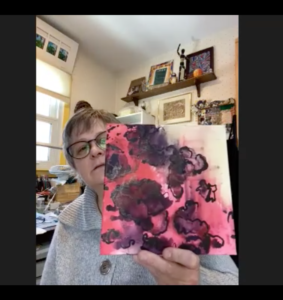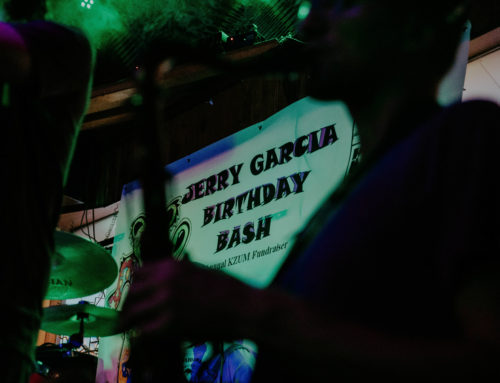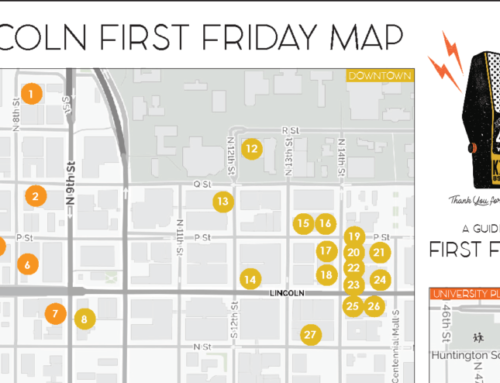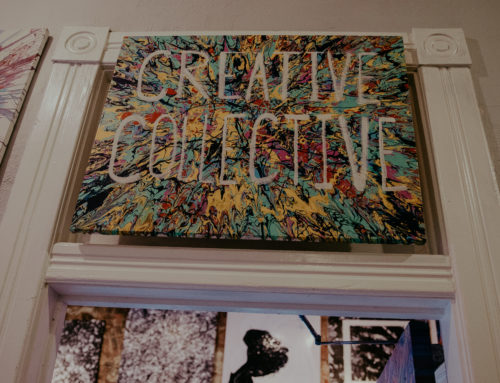Photos by Juliet Bromme
Jan. 28, 2021
She holds up a small, square canvas, painted with bold burgundy flowers scattered across a neon pink background. “I love the colors on that one,” I say.
She smiles. “Yeah, you know, this one is really talkin’ to me lately, but I haven’t quite finished it yet.” I would’ve considered it complete if she hadn’t told me otherwise.
As one who readily admits to a lack of artistic ability, I am easily impressed with each developing creative stage.
 Lynette Fast is a retired art educator and active artist affiliated with several Lincoln-area art museums, including Noyes Art Gallery. She is multi-talented: In addition to painting, she focuses on jewelry, mixed media wall art and spends time manipulating materials such as beads and shells and silver. Fast relies on spontaneity in her creations. “Metal work is really fun and less planned–when you work with metal you have to be pretty forgiving and be able to ebb and flow with it.” In the age of the pandemic, patience and flexibility sound all too familiar.
Lynette Fast is a retired art educator and active artist affiliated with several Lincoln-area art museums, including Noyes Art Gallery. She is multi-talented: In addition to painting, she focuses on jewelry, mixed media wall art and spends time manipulating materials such as beads and shells and silver. Fast relies on spontaneity in her creations. “Metal work is really fun and less planned–when you work with metal you have to be pretty forgiving and be able to ebb and flow with it.” In the age of the pandemic, patience and flexibility sound all too familiar.
Lincoln is home to a multitude of art galleries which cater to the artists, students and residents in the community. As COVID-19 first began its spread, the galleries were forced to acclimate to the new realities that the pandemic presented. For many, the first months of uncertainty resulted in temporarily closed doors. However, this period also presented opportunities to these organizations as they adapted to the coronavirus guidelines and found new footing despite the challenges.
One of the most difficult realities was the capacity restrictions. Since galleries thrive off of the traffic from visitors who congregate around artwork and stroll through the exhibits, they had to think of novel ways to continue accommodating patrons.
Ashley Hussman, director and curator of Great Plains Art Museum, says its visitors are a mix of regulars and newcomers, but they all “have the opportunity to learn something new about the Great Plains and often Nebraska itself through our rotating exhibitions and educational programs.” But, as the University of Nebraska-Lincoln shifted to follow quarantining constraints, so did they. “We were closed from mid-March to mid-August along with much of the university. After re-opening, we have seen a sharp decrease in our in-person visitation.”
To counter the drop in daily turnout that was felt after re-openings, some galleries decided to beef up their online presence and create outdoor art experiences. At the Lux Center for the Arts, Katelyn Farneth, exhibitions director, shares how her team has adjusted to new restrictions: “We’ve been open the entire time, but we’ve done virtual walkthroughs and photographed all the pieces so they are up online.” Over the summer they also produced virtual artist spotlights and continued their summer camps with smaller-sized groups.
The ambition of the Lux Center Founder, Gladys Lux, continues to be seen through the many classes and educational art opportunities that the Lux offers. Continuing these despite the pandemic is important to the organization, Farneth explains.
Many of the Lincoln galleries continue to exist because of the founders’ passions and aspirations. Their dreams are a source of resilience during trials.
Almost three decades ago, Judith Andre bought the dilapidated City Mission Building and renovated part of it into an attractive space where independent artists could show their work and collaborate with like-minded people. The result, Gallery 9, represented her vision coming to fruition.
“Gallery 9 has developed a loyal following of patrons from all walks of life. Because we are artist run, it has enabled artists to develop relationships with our patrons,” Andre says. However, she doesn’t deny that the coronavirus has had negative impacts. “We have many older members and members who are themselves compromised or have family members who are not comfortable working in the gallery at this time, so we have cut the gallery hours back to about half of what they normally are.”
Nonetheless, the obstacles are laced with opportunity. Like other Lincoln creatives, Andre is capitalizing on the slower months by sprucing up the gallery. Repainting and cleaning highlight efforts to maintain a “professional looking presentation so that the art can be appreciated without clutter.”
 Tugboat Gallery, a small space nestled above Gomez Art Supply on N. 14th St., initially had to shut down in March because there wasn’t a safe way to fill its hallways with people. However, during the summer months, they planned a downtown outdoor walk with creative displays in the windows of local businesses.
Tugboat Gallery, a small space nestled above Gomez Art Supply on N. 14th St., initially had to shut down in March because there wasn’t a safe way to fill its hallways with people. However, during the summer months, they planned a downtown outdoor walk with creative displays in the windows of local businesses.
“A lot of small businesses allowed us to use their windows. It would’ve been easier to say no, than yes,” says Peggy Gomez, one of the gallery’s original founders. She is thankful for the support of the Lincoln community, especially during this time.
“Community is always important,” reflects Gomez, “On 14th St. we are all friends.”
The directors and curators express the importance of community during the coronavirus. Not only does it provide connection and camaraderie through the appreciation of art pieces, but support to supplement the challenges faced.
Now, almost thirty years after Julia Noyes established Noyes Art Gallery, it is still providing a diversified space for artists to show their work. “Here,” Noyes emphasizes, “it’s all about community. We never closed [during the pandemic] and people saw that, so we’ve seen a lot of community support. People want to buy local, and support the art. They see a piece and want to reexperience its joy and beauty.”
Throughout the pandemic, the space in the gallery has provided plenty of room to social distance. So, to continue displaying pieces by artists like Lynette Fast, Noyes Art Gallery has remained open.
After Fast tucks away her bright canvases, she confides how she has always wanted to create and be able to show her work and share it with other people. The pandemic has forced many to reimagine how to make that possible, but the support of the city and other creatives make the load a little less heavy to bear.
“It’s great to be part of an artist community,” she beams. “That’s for sure.”
She holds up a small, square canvas, painted with bold burgundy flowers scattered across a neon pink background. “I love the colors on that one,” I say.
She smiles. “Yeah, you know, this one is really talkin’ to me lately, but I haven’t quite finished it yet.” I would’ve considered it complete if she hadn’t told me otherwise.
As one who readily admits to a lack of artistic ability, I am easily impressed with each developing creative stage.

Lynette Fast is a retired art educator and active artist affiliated with several Lincoln-area art museums, including Noyes Art Gallery. She is multi-talented: In addition to painting, she focuses on jewelry, mixed media wall art and spends time manipulating materials such as beads and shells and silver. Fast relies on spontaneity in her creations. “Metal work is really fun and less planned–when you work with metal you have to be pretty forgiving and be able to ebb and flow with it.” In the age of the pandemic, patience and flexibility sound all too familiar.
Lincoln is home to a multitude of art galleries which cater to the artists, students and residents in the community. As COVID-19 first began its spread, the galleries were forced to acclimate to the new realities that the pandemic presented. For many, the first months of uncertainty resulted in temporarily closed doors. However, this period also presented opportunities to these organizations as they adapted to the coronavirus guidelines and found new footing despite the challenges.
One of the most difficult realities was the capacity restrictions. Since galleries thrive off of the traffic from visitors who congregate around artwork and stroll through the exhibits, they had to think of novel ways to continue accommodating patrons.
Ashley Hussman, director and curator of Great Plains Art Museum, says its visitors are a mix of regulars and newcomers, but they all “have the opportunity to learn something new about the Great Plains and often Nebraska itself through our rotating exhibitions and educational programs.” But, as the University of Nebraska-Lincoln shifted to follow quarantining constraints, so did they. “We were closed from mid-March to mid-August along with much of the university. After re-opening, we have seen a sharp decrease in our in-person visitation.”
To counter the drop in daily turnout that was felt after re-openings, some galleries decided to beef up their online presence and create outdoor art experiences. At the Lux Center for the Arts, Katelyn Farneth, exhibitions director, shares how her team has adjusted to new restrictions: “We’ve been open the entire time, but we’ve done virtual walkthroughs and photographed all the pieces so they are up online.” Over the summer they also produced virtual artist spotlights and continued their summer camps with smaller-sized groups.
The ambition of the Lux Center Founder, Gladys Lux, continues to be seen through the many classes and educational art opportunities that the Lux offers. Continuing these despite the pandemic is important to the organization, Farneth explains.
Many of the Lincoln galleries continue to exist because of the founders’ passions and aspirations. Their dreams are a source of resilience during trials.
Almost three decades ago, Judith Andre bought the dilapidated City Mission Building and renovated part of it into an attractive space where independent artists could show their work and collaborate with like-minded people. The result, Gallery 9, represented her vision coming to fruition.
“Gallery 9 has developed a loyal following of patrons from all walks of life. Because we are artist run, it has enabled artists to develop relationships with our patrons,” Andre says. However, she doesn’t deny that the coronavirus has had negative impacts. “We have many older members and members who are themselves compromised or have family members who are not comfortable working in the gallery at this time, so we have cut the gallery hours back to about half of what they normally are.”
Nonetheless, the obstacles are laced with opportunity. Like other Lincoln creatives, Andre is capitalizing on the slower months by sprucing up the gallery. Repainting and cleaning highlight efforts to maintain a “professional looking presentation so that the art can be appreciated without clutter.”

Tugboat Gallery, a small space nestled above Gomez Art Supply on N. 14th St., initially had to shut down in March because there wasn’t a safe way to fill its hallways with people. However, during the summer months, they planned a downtown outdoor walk with creative displays in the windows of local businesses.
“A lot of small businesses allowed us to use their windows. It would’ve been easier to say no, than yes,” says Peggy Gomez, one of the gallery’s original founders. She is thankful for the support of the Lincoln community, especially during this time.
“Community is always important,” reflects Gomez, “On 14th St. we are all friends.”
The directors and curators express the importance of community during the coronavirus. Not only does it provide connection and camaraderie through the appreciation of art pieces, but support to supplement the challenges faced.
Now, almost thirty years after Julia Noyes established Noyes Art Gallery, it is still providing a diversified space for artists to show their work. “Here,” Noyes emphasizes, “it’s all about community. We never closed [during the pandemic] and people saw that, so we’ve seen a lot of community support. People want to buy local, and support the art. They see a piece and want to reexperience its joy and beauty.”
Throughout the pandemic, the space in the gallery has provided plenty of room to social distance. So, to continue displaying pieces by artists like Lynette Fast, Noyes Art Gallery has remained open.
After Fast tucks away her bright canvases, she confides how she has always wanted to create and be able to show her work and share it with other people. The pandemic has forced many to reimagine how to make that possible, but the support of the city and other creatives make the load a little less heavy to bear.
“It’s great to be part of an artist community,” she beams. “That’s for sure.”
Juliet Bromme is a journalism intern with KZUM.



